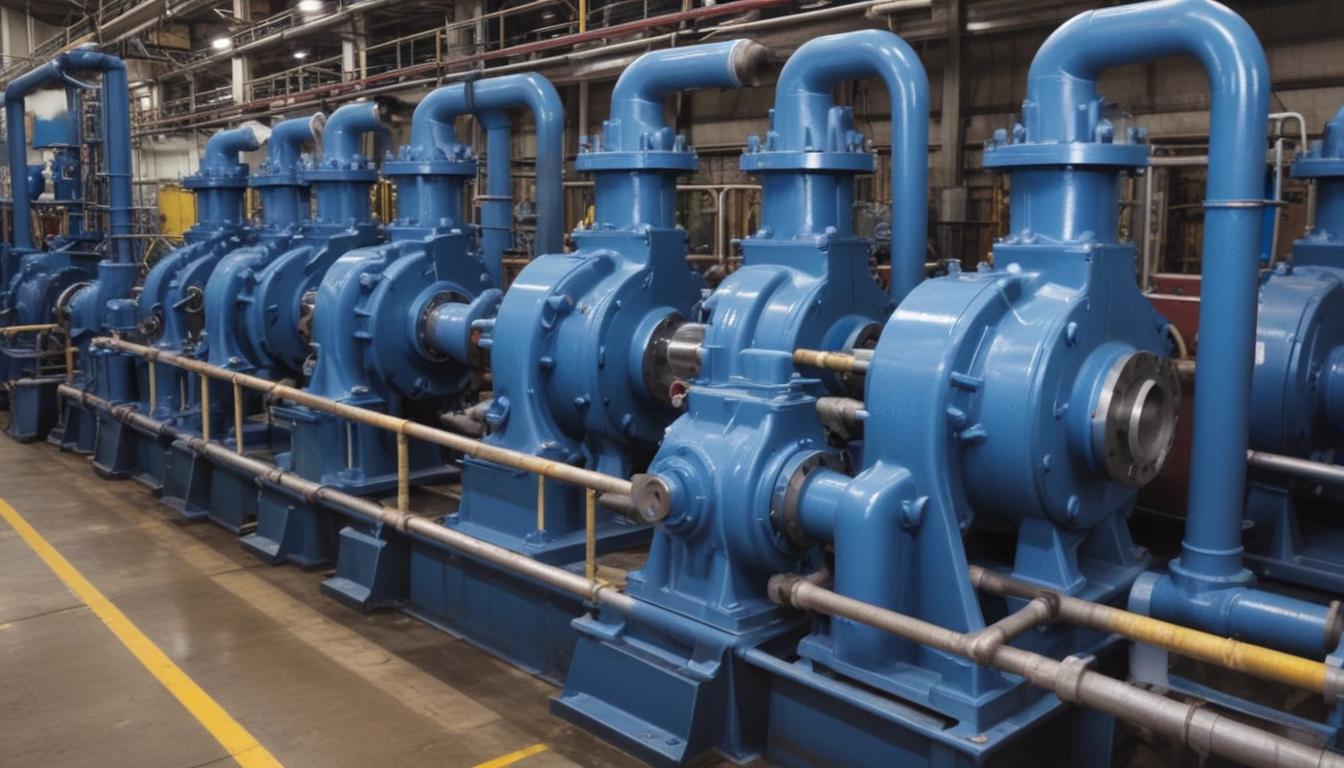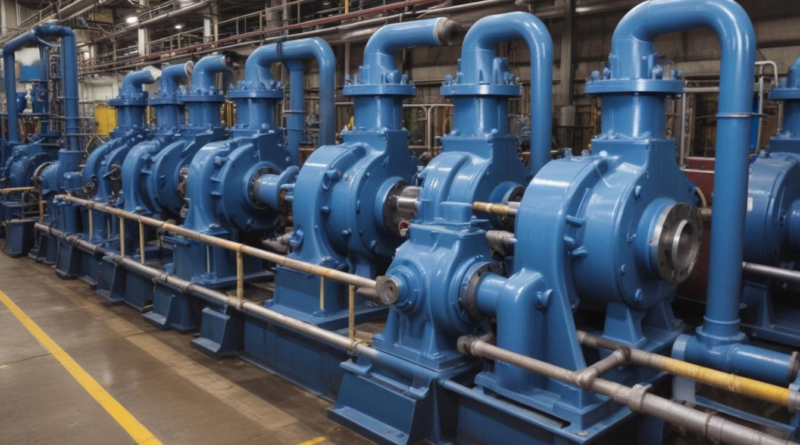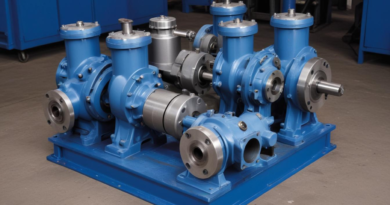reducing noise in pump operations
To effectively mitigate pump noise, it is essential to first identify the primary sources contributing to the unwanted sound. Understanding these sources allows for the implementation of targeted solutions for noise reduction. Common sources of noise in pump operations include:
| Noise Source | Description |
|---|---|
| Mechanical Vibrations | Imbalances in the pump’s moving parts, such as the impeller or shaft, can cause vibrations that generate noise. |
| Hydraulic Turbulence | Irregular flow patterns within the pump lead to turbulent conditions, resulting in noise generation. |
| Bearings and Seals | Worn or inadequate bearings and seals produce rattling or squeaking noises during operation. |
| Motor Noise | The electric motor driving the pump can contribute significantly to overall noise levels, especially if not properly cushioned or isolated. |
| Pipework Resonance | Vibrations transmitted through the piping system can cause resonance, amplifying the noise emitted by the pump. |
Additionally, external factors such as the installation environment and operational conditions can influence the level of pump noise. For instance, installations in confined spaces may exacerbate noise levels, while variations in fluid properties can alter hydraulic dynamics. To comprehensively identify noise sources, the following steps are recommended:
- Conduct a Visual Inspection: Examine all components for signs of wear, misalignment, or damage that could contribute to noise.
- Utilize Vibration Analysis: Employ sensors to measure vibration levels and identify specific components or areas generating excessive vibrations.
- Assess Hydraulic Conditions: Analyze flow rates and pressures to detect irregularities that may cause turbulent flow.
- Evaluate Motor Performance: Monitor the motor for unusual sounds or overheating, which can indicate issues affecting noise levels.
- Inspect Pipework: Check for secure connections and proper supports to prevent vibrations from traveling through the piping system.
By systematically identifying these noise sources, operators can prioritize areas for intervention and develop a comprehensive strategy for noise reduction in pump operations.
implementing noise control measures
Implementing effective strategies to control and reduce unwanted sound emissions is crucial for maintaining optimal pump performance and ensuring a conducive working environment. The following measures can be employed to achieve significant pump noise reduction:
| Noise Control Measure | Description |
|---|---|
| Vibration Isolation | Utilize anti-vibration mounts or pads to decouple the pump from its foundation, minimizing the transmission of mechanical vibrations. |
| Acoustic Enclosures | Install soundproof enclosures around the pump to contain and absorb noise generated during operation. |
| Flexible Pipe Connections | Use flexible couplings or expansion joints in the piping system to reduce the transmission of vibrations and noise. |
| Sound Dampening Materials | Apply acoustic panels or insulating materials to surfaces near the pump to absorb and diminish sound reflections. |
| Regular Maintenance | Conduct routine inspections and maintenance to ensure components such as bearings and seals are in good condition, preventing noise from wear and tear. |
| Operational Adjustments | Optimize pump operating parameters, such as flow rates and pressures, to maintain smooth and stable performance, thereby reducing noise caused by turbulence. |
In addition to the above measures, adopting the following best practices can further enhance noise control efforts:
- Isolation from Structural Elements: Ensure that the pump is not in direct contact with structural components that can propagate vibrations and noise.
- Balancing Rotating Parts: Regularly balance the impeller and other rotating components to prevent imbalances that cause excessive vibrations.
- Seal Integrity: Maintain the integrity of seals to prevent leakages that can contribute to noise generation.
- Motor Isolation: Isolate the motor from the pump using decoupling techniques to reduce motor-related noise transmission.
Furthermore, integrating noise control solutions with the overall system design can lead to more sustainable and long-term noise reduction. It is essential to evaluate the effectiveness of each measure through continuous monitoring and make adjustments as necessary to ensure that noise levels remain within acceptable limits.
By systematically applying these noise control measures, operators can significantly mitigate the adverse effects of pump noise, leading to improved operational efficiency and a safer, more comfortable environment.
maintenance best practices
Effective maintenance is pivotal in ensuring the longevity and optimal performance of pump systems while significantly contributing to noise reduction. Adhering to best practices not only minimizes unwanted pump noise but also enhances operational efficiency and reduces the likelihood of unexpected downtime. The following practices are essential for maintaining a quiet and efficient pump operation:
| Maintenance Best Practice | Description |
|---|---|
| Regular Inspection and Cleaning | Periodically inspect and clean pump components such as impellers, seals, and bearings to prevent debris accumulation that can cause imbalances and increased noise levels. |
| Lubrication of Moving Parts | Ensure that all moving parts, including bearings and shafts, are adequately lubricated to reduce friction and wear, thereby minimizing noise generated from mechanical interactions. |
| Alignment Checks | Regularly verify the alignment of the pump and motor to prevent misalignment issues that can lead to vibrations and excessive noise. |
| Seal Integrity Maintenance | Inspect seals for wear and tear, replacing them as necessary to prevent leaks that can contribute to noise and potential system failures. |
| Vibration Monitoring | Utilize vibration sensors to continuously monitor pump operations, allowing for the early detection of imbalance or misalignment that may cause increased pump noise. |
| Temperature Monitoring | Track the operating temperature of the pump and its components to identify overheating issues that could indicate underlying problems contributing to noise generation. |
Implementing these practices involves a combination of routine tasks and the use of specialized equipment:
- Scheduled Maintenance: Develop and adhere to a maintenance schedule that outlines regular inspection intervals, cleaning routines, and component replacements to ensure consistent performance and noise control.
- Predictive Maintenance Techniques: Employ advanced techniques such as ultrasonic testing and thermal imaging to predict potential failures before they result in significant noise issues or operational disruptions.
- Documentation and Record-Keeping: Maintain detailed records of all maintenance activities, observations, and repairs to identify patterns and inform future maintenance strategies aimed at noise reduction.
- Training and Education: Ensure that maintenance personnel are adequately trained in the latest maintenance procedures and noise control techniques to effectively implement best practices.
Adopting these maintenance best practices not only reduces pump noise but also enhances the overall reliability and efficiency of pump operations. Consistent and thorough maintenance leads to early detection of potential issues, allowing for timely interventions that prevent noise escalation and extend the lifespan of pump systems. By prioritizing maintenance, organizations can achieve a quieter, more dependable, and cost-effective pumping infrastructure.
selecting quiet pump models
 When selecting quiet pump models, it is crucial to consider various factors that contribute to effective noise reduction. Choosing the right pump not only minimizes environmental impact but also enhances operational efficiency and workplace comfort. The following aspects should be evaluated to identify the most suitable pump models for noise-sensitive applications:
When selecting quiet pump models, it is crucial to consider various factors that contribute to effective noise reduction. Choosing the right pump not only minimizes environmental impact but also enhances operational efficiency and workplace comfort. The following aspects should be evaluated to identify the most suitable pump models for noise-sensitive applications:
| Factor | Description |
|---|---|
| Pump Type | Different pump types inherently produce varying noise levels. For instance, centrifugal pumps are generally quieter than positive displacement pumps due to their continuous flow characteristics. |
| Design Features | Pumps equipped with features such as balanced impellers, precision bearings, and noise-dampening casings tend to operate more quietly. |
| Material Composition | Using materials with high vibration damping properties, such as stainless steel or composite materials, can significantly reduce noise emissions. |
| Isolation Mechanisms | Pumps that include built-in vibration isolation mounts or flexible couplings help minimize the transmission of vibrations to surrounding structures. |
| Motor Specifications | Selecting motors designed for low noise operation, such as those with enclosed bearings and insulated windings, can contribute to overall noise reduction. |
| Flow Rate and Pressure | Operating pumps within their optimal flow rate and pressure ranges ensures smooth performance, reducing turbulence and associated noise. |
| Efficiency Ratings | High-efficiency pumps operate with less energy loss and lower mechanical stress, resulting in quieter operation. |
To systematically approach the selection process, consider the following steps:
- Assess Operational Requirements: Determine the necessary flow rates, pressures, and the type of fluid being pumped to identify suitable pump types that align with performance needs while ensuring low noise generation.
- Evaluate Manufacturer Specifications: Review product datasheets and manufacturer specifications to compare noise levels, typically indicated in decibels (dB), for different pump models.
- Consider Environmental Factors: Analyze the installation environment, including space constraints and ambient noise levels, to select pumps that can maintain acceptable noise levels under specific conditions.
- Review Compliance Standards: Ensure that the selected pump models comply with relevant noise regulations and industry standards, which can vary depending on the application and location.
- Consult with Manufacturers: Engage with pump manufacturers or suppliers to discuss noise reduction solutions and seek recommendations based on specific application requirements.
Additionally, integrating advanced technologies can enhance the quiet operation of pump systems:
- Variable Frequency Drives (VFDs): Implementing VFDs allows precise control over pump speed, enabling operation at optimal points that minimize noise.
- Acoustic Monitoring Systems: Utilizing real-time acoustic monitoring can help in maintaining noise levels within desired ranges and promptly addressing any deviations.
- Modular Pump Designs: Selecting modular pumps facilitates easier maintenance and the replacement of noise-sensitive components without significant downtime.
When comparing different pump models, the following table highlights key features that contribute to quieter operation:
| Pump Model | Noise Level (dB) | Notable Features | Applications |
|---|---|---|---|
| Model A | 65 | Balanced impeller, enclosed motor | HVAC systems, water circulation |
| Model B | 70 | Flexible couplings, vibration dampers | Industrial processing, chemical handling |
| Model C | 60 | Advanced sealing, acoustic insulation | Pharmaceuticals, food and beverage |
| Model D | 68 | Variable frequency drive compatibility, high-efficiency motors | Pumping stations, wastewater treatment |
By carefully evaluating these factors and utilizing structured selection criteria, organizations can effectively choose pump models that meet their performance needs while ensuring minimal pump noise. This strategic approach not only enhances operational efficiency but also contributes to a more comfortable and compliant working environment.
monitoring and evaluation
Effective monitoring and evaluation are essential components in ensuring the sustained success of noise reduction initiatives within pump operations. By systematically tracking noise levels and assessing the performance of implemented solutions, organizations can identify areas for improvement and maintain optimal operational conditions. The following strategies outline a comprehensive approach to monitoring and evaluating pump noise:
| Monitoring Aspect | Description |
|---|---|
| Noise Level Measurement | Utilize sound level meters and acoustic sensors to continuously monitor the decibel levels emitted by pump systems. Regular measurements help in identifying fluctuations and ensuring that noise levels remain within acceptable limits. |
| Vibration Analysis | Employ vibration monitoring tools to detect abnormal vibrations that may indicate mechanical issues contributing to increased pump noise. Early detection allows for timely maintenance and noise mitigation. |
| Operational Data Logging | Implement data logging systems to record operational parameters such as flow rates, pressures, and pump speeds. Analyzing this data helps in correlating operational conditions with noise levels. |
| Environmental Monitoring | Assess the surrounding environment for factors that may influence noise perception, such as ambient noise levels and installation layout. This ensures a holistic understanding of noise impacts. |
| Compliance Tracking | Ensure that noise emissions comply with local regulations and industry standards by maintaining detailed records of noise measurements and implementing corrective actions when necessary. |
To effectively evaluate the success of noise reduction measures, the following evaluation methods should be employed:
- Baseline Establishment: Determine the initial noise levels before implementing any noise control solutions. This provides a reference point for measuring the effectiveness of subsequent interventions.
- Performance Benchmarking: Compare current noise levels against industry benchmarks and regulatory standards to assess compliance and identify areas requiring improvement.
- Trend Analysis: Analyze noise level trends over time to identify patterns, seasonal variations, or the impact of specific operational changes on noise emissions.
- Effectiveness Assessment: Evaluate the performance of noise control measures by comparing post-implementation noise levels with baseline measurements. Determine the return on investment (ROI) for each solution based on noise reduction achieved.
- Feedback Integration: Collect feedback from personnel and stakeholders regarding perceived noise levels and the effectiveness of noise reduction efforts. Incorporate this feedback into continuous improvement processes.
Implementing these evaluation techniques involves the use of specialized tools and technologies:
- Acoustic Modeling Software: Utilize software to simulate and predict noise propagation within the installation environment, aiding in the design of effective noise control measures.
- Real-Time Monitoring Systems: Deploy real-time monitoring systems that provide instant feedback on noise levels, enabling prompt responses to any deviations from desired standards.
- Data Analytics Platforms: Leverage data analytics to interpret large volumes of monitoring data, facilitating informed decision-making and proactive noise management.
Key Performance Indicators (KPIs) for monitoring and evaluation include:
| KPI | Description |
|---|---|
| Average Noise Level (dB) | Measures the mean decibel level over a specified period, providing an overall indication of pump noise. |
| Peak Noise Levels | Identifies the highest noise levels recorded, highlighting instances where noise control measures may need reinforcement. |
| Noise Reduction Percentage | Calculates the percentage decrease in noise levels achieved through implemented solutions compared to baseline measurements. |
| Compliance Rate | Tracks the extent to which noise emissions meet regulatory and industry standards, aiming for 100% compliance. |
| Maintenance Response Time | Measures the time taken to address maintenance issues identified through noise monitoring, ensuring swift action to minimize noise impacts. |
Regular review meetings should be scheduled to discuss monitoring results, evaluate the effectiveness of noise reduction strategies, and plan necessary adjustments. By maintaining a structured monitoring and evaluation framework, organizations can ensure that pump noise remains controlled, and noise reduction initiatives continue to deliver the desired outcomes. This proactive approach not only enhances operational efficiency but also promotes a safer and more comfortable working environment.




